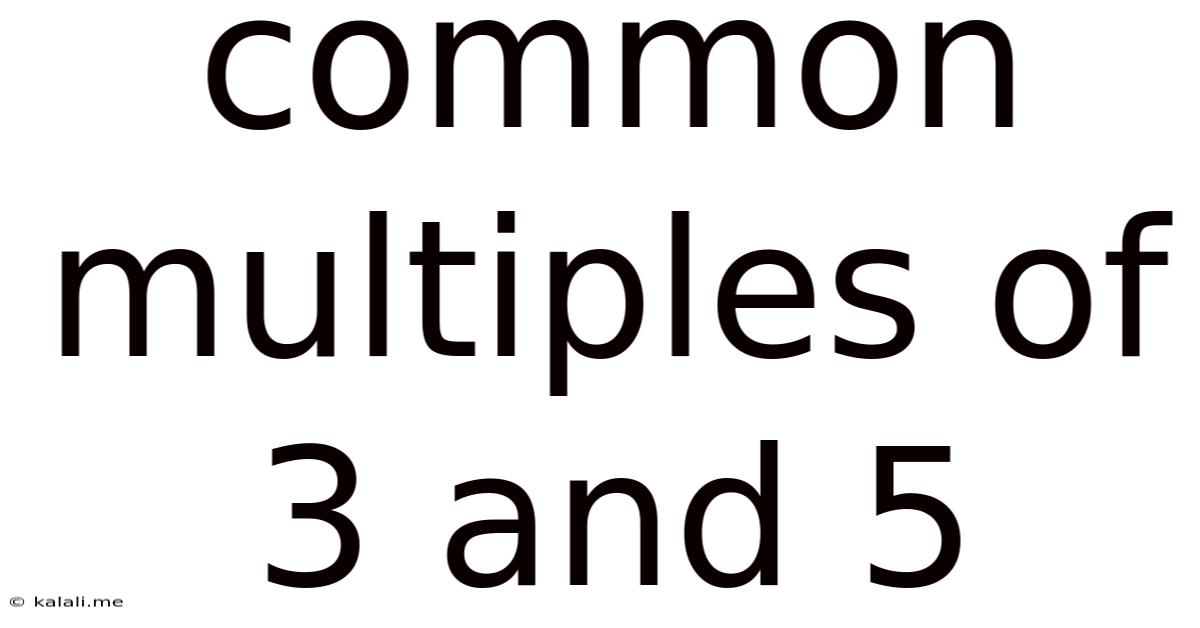Common Multiples Of 3 And 5
Kalali
May 07, 2025 · 3 min read

Table of Contents
Understanding Common Multiples of 3 and 5: A Comprehensive Guide
Finding common multiples, especially those of 3 and 5, might seem like a simple math problem. However, understanding the underlying concepts and different methods for solving them is crucial for various mathematical applications. This article delves into the world of common multiples, focusing specifically on 3 and 5, explaining the process clearly and providing practical examples. We'll explore different approaches, from listing multiples to using the least common multiple (LCM), making this a valuable resource for students and anyone looking to refresh their mathematical knowledge.
What are Multiples?
Before diving into common multiples, let's clarify what a multiple is. A multiple of a number is the product of that number and any whole number (0, 1, 2, 3, and so on). For example:
- Multiples of 3: 0, 3, 6, 9, 12, 15, 18, 21, 24, 27, 30...
- Multiples of 5: 0, 5, 10, 15, 20, 25, 30, 35, 40, 45, 50...
Identifying Common Multiples
Common multiples are numbers that appear in the lists of multiples for two or more numbers. Looking at the lists above, we can easily identify some common multiples of 3 and 5:
- 15: It's both a multiple of 3 (3 x 5 = 15) and a multiple of 5 (5 x 3 = 15).
- 30: It's a multiple of 3 (3 x 10 = 30) and a multiple of 5 (5 x 6 = 30).
- 45: It's a multiple of 3 (3 x 15 = 45) and a multiple of 5 (5 x 9 = 45).
And so on. There are infinitely many common multiples of any two numbers (excluding zero).
Finding Common Multiples: Listing Method
The simplest method to find common multiples is by listing the multiples of each number and identifying the common ones. This works well for smaller numbers but becomes less efficient for larger numbers.
Example: Find the first three common multiples of 3 and 5.
- List the multiples of 3: 3, 6, 9, 12, 15, 18, 21, 24, 27, 30...
- List the multiples of 5: 5, 10, 15, 20, 25, 30, 35...
- Identify the common multiples: 15, 30, 45...
Therefore, the first three common multiples of 3 and 5 are 15, 30, and 45.
Finding Common Multiples: Using the Least Common Multiple (LCM)
A more efficient approach, especially for larger numbers, involves finding the Least Common Multiple (LCM). The LCM is the smallest positive number that is a multiple of two or more numbers. Once you find the LCM, all other common multiples are multiples of the LCM.
There are several ways to calculate the LCM:
- Listing Method (for smaller numbers): This involves listing multiples as shown above and identifying the smallest common one.
- Prime Factorization: This method involves finding the prime factorization of each number and then taking the highest power of each prime factor present in the factorizations.
Example (using Prime Factorization): Find the LCM of 3 and 5.
- Prime factorization of 3: 3 (3 is a prime number)
- Prime factorization of 5: 5 (5 is a prime number)
- LCM: Since 3 and 5 are prime numbers and have no common factors, their LCM is simply their product: 3 x 5 = 15.
All common multiples of 3 and 5 are multiples of 15 (15, 30, 45, 60, and so on).
Applications of Common Multiples
Understanding common multiples is essential in various areas, including:
- Scheduling: Determining when events that occur at different intervals will coincide. (e.g., two buses arrive at a stop every 3 and 5 minutes respectively; when will they arrive simultaneously?)
- Fraction operations: Finding the least common denominator when adding or subtracting fractions.
- Measurement: Converting units of measurement.
In conclusion, finding common multiples, particularly those of 3 and 5, is a fundamental concept in mathematics with practical applications. By understanding the different methods—listing multiples and utilizing the LCM—you can efficiently solve problems related to common multiples and apply this knowledge to various mathematical contexts.
Latest Posts
Latest Posts
-
What Is A 56 Out Of 60
Aug 03, 2025
-
How Long Does Brandy Melville Take To Ship
Aug 03, 2025
-
Which Element Is More Likely To Become A Anion
Aug 03, 2025
-
What Do Parables And Fables Have In Common
Aug 03, 2025
-
Her Tears Like Diamonds On The Floor Lyrics
Aug 03, 2025
Related Post
Thank you for visiting our website which covers about Common Multiples Of 3 And 5 . We hope the information provided has been useful to you. Feel free to contact us if you have any questions or need further assistance. See you next time and don't miss to bookmark.